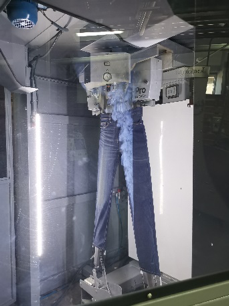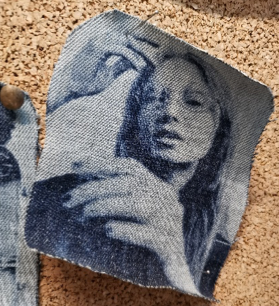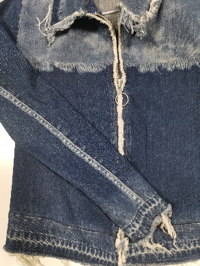Making innovation in design processes more accessible
- Anna Schuster
- Jan 16, 2020
- 5 min read
Updated: Sep 18, 2020

London’s only jeans maker producing raw, selvedge and organic denim, right in the heart of Walthamstow, Blackhorse Lane Ateliers – hosted a research residency as part of ‘Making For Change: Waltham Forest’ a project led by Dr Francesco Mazzarella.
In which the research residency was to investigate sustainability issues related to denim, which is known to be one of the most water-intensive materials used in fashion. With the production of a pair of jeans requiring up to 7,000 litres of water (Levi Strauss & Co. 2015) and every year 1.7 million tons of chemicals used to produce two billion pairs of jeans (Webber, 2018).
Anna Schuster, a London College of Fashion (LCF) alumna and co-founder of sustainable fashion brand JOA – shares with us her experience on the residency at Blackhorse Lane Ateliers. During the research residency, I have explored and experimented with sustainable and efficient garment finishing processes that reduce water, chemical consumption, and manual labour. As an outcome of this residency, a feasibility study was developed for establishing a Wash Lab in East London equipped with innovative wash machines and laser technology. The vision is to provide independent designers, fashion brands and students with space where they could undertake research and development, local prototyping and production. This would also allow the development of denim wash aesthetic specific to London, forward-thinking materials and laundry techniques.
Looking deeper into the social-oriented business model of Blackhorse Lane Ateliers, which focuses on quality and craftsmanship.
With an aim to bring back the appreciation for garments, and not only to develop a sustainable product – but a transparent production process with a positive social impact on the community, supporting localism and diversity. Through their actions, Blackhorse Lane Ateliers want to bring back the mentality of making to London, incorporating diversity and non-fashion disciplines.
Investigating innovation and technology at Jeanologia
To investigate innovation and technology you must understand how it works and why it is useful, in order to bring those innovations through into the design process. I spent three days at the headquarters of Jeanologia, to gain a deeper understanding of what power technology can have and how this can impact process changes in the denim industry.
I explored the company and gained insights into their brand philosophy and way of working, helping me to understand their bigger aims. Not only through the way they have developed their technology but also, their business approach – a holistic perspective that addresses sustainability, craftsmanship and innovation.
This research was a chance to explore two companies with disruptive business models, and to compare their values and visions to develop scenarios of how to democratise technology.
Using technology does not mean to be sustainable per se – this is clear. We need to use technology to improve processes and think innovatively to control what we design and produce.
"The companies I looked into have a clear mission, that is to create an ethical, sustainable and eco-efficient textile and apparel industry." – Anna Schuster
To be more concrete, for Jeanologia it is about not just developing and promoting their technologies, but also educating and helping their customers to achieve improvements in every step of the textile finishing process. My research at Jeanologia started with a tour of the company and its departments, starting at the melting pot: the Brain Box. People with diverse professional backgrounds working in an interdisciplinary way in research and development.
This is the way we must work in the future: we must exchange knowledge and expertise. We should have the time and space to experiment. Designers, physicists, technicians, etc. must work together to activate change in the fashion industry. Which fits alongside the vision of Blackhorse Lane Ateliers – to bring makers, designers and artists together to grow.
Combining technology, art and design
What was clear throughout my research was the respect toward the craftsmanship of denim finishing combined with the vision to use technology to address the needs of our time. To manipulate the surfaces by hand scraping/stone washing etc. is a traditional way but not contemporary nor in any way appropriate for the current model of consumerism. The demand of the market has changed, we need new production approaches and we need to invent new professions.
Innovation needs training…
The approach of educating and sharing the knowledge to allow others to improve their process is needed in order to activate change. Currently the technology is attached to a service – to help, educate and consult the ones using it, and does not end with the purchase. We need to think about long-term relationships if we develop a product, technology or service. It is essential to think of the constant progress and improvements that go hand in hand with design and technology. In addition to technological innovation, we need new disruptive business models like that of Blackhorse Lane Ateliers and places that allow us to DO things.
Accessible at small scale

Access to technology and innovation should not be a privilege that is just for big companies. No doubt technology means investment, that usually cannot be done by smaller brands and is unrealistic for many independent designers. But there are ways to allow access to research and development, and smaller productions for small-scale fashion brands.
The future needs spaces – Wash Labs and Innovation Hubs
The future needs spaces that allow access for independent designers, local makers, small to medium-sized fashion brands and especially to students (the designers of tomorrow). Those are the designers who have the time and freedom to experiment and explore, those who can think outside the box and experiment with different perspectives – allowing innovation to happen. Research can be done in terms of testing material innovation in a commercial context, exploring and testing bio- design and developing alternatives within dye processes. Laundry techniques and the impact of microfibres are a field that still needs to be explored, due to our changed consumerism and behaviour in terms of washing / treatment of our garments, fibre content and increased usage of recycled materials we have to investigate in the long term issues of our changed washing habits and materials. For me, this technology is the beginning of a revolution in the textile and garment finishing industry. The impact of the last step of the design process is too often overlooked within the process of fashion design. But there is too much potential to improve and change the current techniques – we are forced to develop new business models and rethink our design processes.
So, why not start with the idea that trash is our new raw material? How can the technology of garment finishing help to design against landfill?
To create scenarios of how a social focussed fashion brand can create maker-spaces for itself but also for the community was not only inspiring but essential as to think about ways to democratise innovation. Watching videos of new processes, reading facts on how much water is saved by using innovative technologies helped me as a designer to understand why we need to rework traditional processes.
The research that I have done and the perspectives I collected helped me to connect personal interests. Being inside Blackhorse Lane Ateliers and Jeanologia, seeing their ways of working and their motivation to think beyond growth and profit. Working toward an industry that allows research and education within a commercial space, was more insight than I could have hoped to gain.
"We need to learn new tools and make innovation accessible for everyone to be able to sustain fashion design in the 21st century without destroying our planet." – Anna Schuster
Find out more about Making for Change: Waltham Forest



















Comments